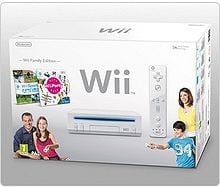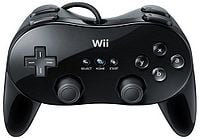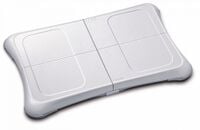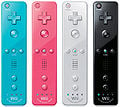Wii
| Wii | |
|---|---|
 The first version of the Wii | |
| Generation | Seventh generation |
| Release date | Wii: Template:Release Wii Family Edition: Template:Release Wii mini: Template:Release[?] |
| Discontinued | Wii (Overall): Template:Release Wii (Original): Template:Release Wii Family Edition: Template:Release Wii mini: 2017[?] |
| Predecessor | Nintendo GameCube |
| Successor | Wii U |
The Wii is a home video game console created by Nintendo as the successor to the Nintendo GameCube. It was released on November 19, 2006, in North America for $249.99. It was then released in Japan on December 2, 2006; Oceania on December 7, 2006; and Europe on December 8, 2006. This is one of three Nintendo game consoles sold in North America before Japan, the others being the original Nintendo DS and the Wii U. Before the Wii's final name was announced on April 27, 2006, the console was codenamed "Revolution."
Unlike with the Nintendo GameCube, Wii game discs use the standard DVD size, which allows them to hold more memory than the GameCube discs: up to 4.37 GB for single-layered discs, and up to 7.92 GB for dual-layered discs. However, the Wii is backwards compatible with most Nintendo GameCube games, and it is the first Nintendo home console to be backwards compatible with its predecessor. It has four GameCube controller ports, meaning GameCube games can be inserted into the disc slot and be played on the Wii.
The system had integrated Nintendo Wi-Fi Connection functionality, enabling players to interact with other players around the world while playing certain games, such as Mario Kart Wii.
Although the Nintendo GameCube was the first Nintendo home console since the Family Computer to not have a Super Mario series game at launch, the Wii is the first home console to not have a game from the Super Mario franchise as a launch title (except in Japan). The Wii's first Super Mario game is WarioWare: Smooth Moves, which came out on December 2, 2006, in Japan as a launch title; January 12, 2007, in Europe; January 15, 2007, in North America; and January 25, 2007, in Oceania. The first Super Mario game for the Wii starring Mario is Super Paper Mario, except in PAL regions, where Mario Strikers Charged was the game instead.
In 2012, the Wii was succeeded by the Wii U, which can still play Wii games and utilizes controllers with backwards compatibility.
Since May 20, 2014, online play for many Wii games has been discontinued because the Nintendo Wi-Fi Connection service has discontinued.[1]
Models
Wii Family Edition
The Wii Family Edition (RVL-101) was announced on August 17, 2011. This model is designed to only sit horizontally (with the buttons changed accordingly) and is incompatible with the Nintendo GameCube's software and its accessories. This model was released in North America on October 23, 2011 and in Europe on November 4, 2011 in order to replace the older model and stop its production. The Wii Family Edition includes a black console, the game New Super Mario Bros. Wii, and the Super Mario Galaxy Original Soundtrack. The Wii Family Edition's release in North America was not originally intended to replace the older version of the Wii.[2]
Wii mini
The Wii mini (RVL-201)[3] was announced on November 27, 2012. As its name suggests, the Wii mini is the smallest model of the Wii. Like the Wii Family Edition, it is missing some features such as the compatibility with Nintendo GameCube and its accessories. It also does not have online features and several built-in channels, such as the Photo Channel and the Weather Channel, similar to the Wii Mode on the Wii U. It also can only sit horizontally. The main feature is its notable redesign. Unlike the original Wii or the Wii Family Edition which are mostly white, the Wii mini is black with a red framing. All the buttons are located on the top of the console, and it lacks online support for Wii games. Additionally, the Wii mini has a manually operated top-loading disc drive (similar to the GameCube) instead of the slots that former models have. The console launched in Canada on December 7, 2012 for $99.99[4]. It was then released in Europe on March 22, 2013 at a cost of at least £79.99[5]. It was launched in North America on November 17, 2013 bundled with a red Wii Remote Plus and a red Nunchuk for $99.99[6]. The Wii mini is the third home Nintendo console since the SNES and NES to receive a redesign right after its respective successors launched though the NES 101 model launched 2 years after the SNES launched. The N64 received no redesigns of any kind, and the GameCube had a small revision that lacked the unused Serial Port 2 (though the cover still remains) and the unpopular Digital AV Out port.
Virtual Console
- Main article: Virtual Console
In addition to being backwards-compatible with Nintendo GameCube games, the Wii Shop Channel has a section called Virtual Console, which allows the players to download emulated versions of games from the Nintendo 64 era and before to play on the Wii. Many of them were Super Mario games. Each downloaded game costs between 500 and 1000 Wii Points. The games are priced based on the system they were released on, with imported games generally costing an additional 100 points, or 200 points for Nintendo 64 games.
The Virtual Console versions of games are primarily straight emulations with no major changes or additions, although a few games such as Super Mario RPG: Legend of the Seven Stars and Mario Kart 64 are edited to remove potentially seizure-inducing or copyright-infringing graphics. Additionally, Nintendo 64 games do not support the Rumble Pak or Transfer Pak accessories, meaning parts of games that use these features may not function completely in the Virtual Console version.
The Wii Virtual Console is also accessible from the Wii U inside Wii mode, independently from the Wii U's own Virtual Console.
Wii Message Board
The Wii Message Board, powered by WiiConnect24, was a messaging system that users could use to send messages to other Wii users prior to its discontinuation. The user could either register a different Wii Friend Code separate from the games that use Friend Code exchange or send a friend request to someone that uses a third-party e-mail service, such as Hotmail or Gmail. The service was discontinued on June 27, 2013.[7] Super Mario Galaxy, Super Mario Galaxy 2, and Mario Kart Wii use this feature separately from WiiConnect24.
In Super Mario Galaxy, the Mailtoad will send images to the Wii Message Board if both Mario and Luigi talk to him in the mission The Star Festival.
In Mario Kart Wii, a picture of the playable Mario, Peach, and the player's Mii before the player gets all gold on all courses or a picture of all the playable characters with the player's Mii after the player gets all gold is sent to the Wii Message Board upon the player finishing the credits.
In Super Mario Galaxy 2, a picture is obtained when the player beats Bowser one time and another once the player beats the game 100%.
The Wii is Nintendo's first home console with a wide variety of built-in software. Wii Channels are channels accessible from the Wii Menu. There are four pages of channels; each page can hold twelve channels, meaning there can be in total 48 channels in a typical Wii Menu. The channels can be moved around on the Wii Menu by holding ![]() +
+ ![]() and dragging them.
and dragging them.
Disc Channel
The Disc Channel is the channel in which game discs are loaded and played. It is the first channel on the menu and cannot be moved. It displays a preview icon of the game currently inside the disc slot and plays a unique jingle when selected; if a Nintendo GameCube game is in the slot, it does not have a preview and only displays the Nintendo GameCube logo and plays the default GameCube startup jingle when selected. When a disc is loading, as seen in the picture, the Nintendo GameCube and Wii discs are shown spinning, and whichever disc type that was inserted will lower into an opening denoting a disc reader.
- Names in other languages
| Language | Name | Meaning | Notes |
|---|---|---|---|
| Spanish | Canal Disco[?] | Disc Channel |
Mii Channel

Miis are customized characters that can be used in various Wii games, including games such as Mario Party 8, Mario Kart Wii and the Mario & Sonic games. A maximum of 100 Miis can be created and saved in the Mii Channel in the Mii Plaza. By using WiiConnect24, friends' Miis can be displayed in the Mii Parade; a parade of various Miis saved on friends' Mii Channels. Miis can also be stored in Wii Remotes, with a maximum capacity of 10. These Miis can then be transported to a different Wii by using the Wii Remote on a different Wii and then loading the Miis from the controller. The option to transfer Miis to a supporting Nintendo 3DS system can be unlocked by pressing ![]() ,
, ![]() ,
, ![]() , and
, and ![]() in that order.[8]
in that order.[8]
- Names in other languages
| Language | Name | Meaning | Notes |
|---|---|---|---|
| Spanish | Canal Mii[?] | Mii Channel |
Photo Channel
The Photo Channel allows the user to save, view, and apply various effects to photos and videos from either an SD card or the Wii Message Board. Effects include doodling, stamping, and altering brightness settings. Photos can also be turned into sliding puzzles. When the game Mario Kart Wii is beaten, the player is given the choice whether or not to send the winning photo to the Message Board. There are several other games that behave like this such as Super Mario Galaxy and Super Mario Galaxy 2.
- Names in other languages
| Language | Name | Meaning | Notes |
|---|---|---|---|
| Spanish | Canal Fotos[?] | Photos Channel |
Wii Shop Channel
The Wii Shop Channel was a virtual shopping network where users could purchase and download WiiWare and Virtual Console games in exchange for the required amount of Wii Points. The Virtual Console allowed players to download games that were originally released on the NES, SNES, and Nintendo 64, and play them on their Wii console. They could also buy special games called WiiWare which can be purchased only on the Wii Shop Channel itself. Rather than using money to directly buy the games, a credit currency called Wii Points is used. Wii Points can be earned by either purchasing them with a credit card or redeeming a Wii Point Card. Other free-of-charge channels, such as the Nintendo Channel and Internet Channel, were also available for download at the Wii Shop Channel.
When downloading a game or channel from the Wii Shop Channel, one would be asked to verify their purchase (if Wii Points are needed), after which they will be presented with the download screen. The download screen consisted of an 8-bit Mario character continuously running across the bottom of the screen and collecting coins as they moved towards him. The progress of the download was indicated by three Brick Blocks floating above 8-bit Mario's head, which he will jump up and hit as he runs across the screen. Every time the download progresses 33%, a Brick Block would have turned into an Empty Block. The final Brick Block represents the point at which the download has reached 99%. When 8-bit Mario reaches this block, he would jump and hit it multiple times and continue to do so until the download was complete.
Sometimes, Fire Mario would have appeared instead of regular Mario. When this happens, one could have made Fire Mario shoot fireballs while the download was in progress by pressing the ![]() button. Occasionally, 8-bit Luigi appears in place of 8-bit Mario, or both 8-bit Mario and 8-bit Luigi would swim across the screen instead of running across it. There is a total of six different animations one may have experienced while downloading software from the Wii Shop Channel, some of which appear more often than others.
button. Occasionally, 8-bit Luigi appears in place of 8-bit Mario, or both 8-bit Mario and 8-bit Luigi would swim across the screen instead of running across it. There is a total of six different animations one may have experienced while downloading software from the Wii Shop Channel, some of which appear more often than others.
The Wii Shop Channel service was discontinued on January 30, 2019, though the ability to add Wii Points was discontinued on March 26, 2018. Between these times, users would have still been able to browse and download purchased software.[9]
The Nintendo 3DS, Wii U, and Nintendo Switch have a similar online shop called the Nintendo eShop. The Nintendo DSi also had an online shop (simply called the Nintendo DSi Shop), but that shop was also discontinued.
8-bit Mario appearing on the Wii Shop Channel download screen
- Names in other languages
| Language | Name | Meaning | Notes |
|---|---|---|---|
| Spanish | Canal Tienda Wii[?] | Wii Shop Channel |
Forecast Channel
The Forecast Channel was added on December 19, 2006, about one month after the console itself was released. The channel preview displayed the local weather of where the user is located. Some games, including Mario & Sonic at the Olympic Winter Games, have an option that allowed the game to draw information from the Forecast Channel and use that weather as the weather conditions in the game.
- Names in other languages
| Language | Name | Meaning | Notes |
|---|---|---|---|
| Spanish | Canal Tiempo[?] | Time Channel |
Virtual Console Channels
Virtual Console channels are downloadable games that can be purchased from the Wii Shop Channel at varying prices. These various channels allow users to play classic NES, SNES, and Nintendo 64 games such as Donkey Kong, Super Mario World, and Super Mario 64. The Virtual Console also supports selected games from the Sega Genesis/Mega Drive and the TurboGrafx-16 systems. Although some games can be played using the Wii Remote, others require the use of either a Nintendo GameCube controller or a Classic Controller.
Mario Kart Channel

The Mario Kart Channel is a channel specifically made to work with Mario Kart Wii. Once installed from the game, this channel can be used to register friends, race ghosts, race friends or random users, enter tournaments, and get updates from Nintendo or other players. The Nintendo 3DS game Mario Kart 7 also includes Mario Kart Channel as an in-game mode, though it has different features.
- Names in other languages
| Language | Name | Meaning | Notes |
|---|---|---|---|
| Chinese (traditional) | 瑪利歐賽車頻道[10] Mǎlì'ōu Sàichē Píndào |
Mario Kart Channel | |
| Spanish | Canal Mario Kart[?] | Mario Kart Channel |
WiiWare channels
- Main article: WiiWare
WiiWare was a feature that was launched for the Wii Shop Channel in 2008, which consisted of smaller-sized games that could be downloaded onto the Wii or SD card memory using Wii Points, which would then appear on the Wii Menu as individual channels. Some Super Mario WiiWare titles included Dr. Mario Online Rx and WarioWare: D.I.Y. Showcase. Some WiiWare titles used Nintendo Wi-Fi connection, allowing the player to play with other Wii players over the internet. Others included Mii compatibility, allowing players to play the game as their own Mii created in the Mii Channel. Also, some games allowed the player to transfer and use the data from a Nintendo DS game, such as WarioWare D.I.Y. Showcase.
Peripherals
Wii Remote
The Wii Remote (also known as the "Wiimote") is the standard game controller for the Wii. It has a rectangular shape, resembling a television remote, making it unique from other consoles' controllers. It consists of several buttons (one behind (![]() )) and a directional pad (
)) and a directional pad (![]() ) as well. The Wii Remote also has a power button (
) as well. The Wii Remote also has a power button (), which can be used as a remote to either turn the Wii console on or off, rather than pressing the power button on the machine itself. The Wii Remote can be used for NES Virtual Console games but not for SNES and N64 Virtual Console games because the Wii Remote cannot be mapped to emulate a SNES or N64 controller properly.
Buttons
- A (
 )
) - B (
 )
) - Home (
 )
) - + (
 )
) - - (
 )
) - 1 (
 )
) - 2 (
 )
) - +Control Pad (
 )
) - Power (
)
Wii Remote Plus
The Wii Remote Plus is an upgraded version of the Wii Remote, which includes the Wii MotionPlus attachment's system incorporated in the controller. The Wii Remote Plus was shown in the Nintendo's conference of September 2010, and is available in white, black, pink, cyan, and red colors. It was released in Europe on November 5, 2010 and in Japan on November 11, 2010.
Mario & Sonic at the Sochi 2014 Olympic Winter Games for the Wii U was the only game of the Super Mario franchise to ever use the Wii MotionPlus.
Nunchuk
The Nunchuk is the main attachment to the Wii Remote. Upon buying a Wii, one Wii Remote and one Nunchuk are included. It consists of two buttons (![]() and
and ![]() ) along with an analog stick (
) along with an analog stick (![]() ). Like the Wii Remote, the Nunchuk also includes motion sensors. It is named as such because of the similarity in appearance to nunchaku when being used together with the Wii Remote.
). Like the Wii Remote, the Nunchuk also includes motion sensors. It is named as such because of the similarity in appearance to nunchaku when being used together with the Wii Remote.
- Names in other languages
| Language | Name | Meaning | Notes |
|---|---|---|---|
| Japanese | ヌンチャク[?] nunchaku |
Nunchuk | |
| Chinese (simplified) | 拿趣酷[11] Náqùkù |
Transliteration of Nunchuk, also means "To hold Fun and Cool" | |
| Chinese (traditional) | 雙截棍控制器[12] Shuāngjiégùn Kòngzhìqì |
Nunchuk Controller |
Buttons and Stick
- C (
 )
) - Z (
 )
) - Control Stick (
 )
)
Classic Controller
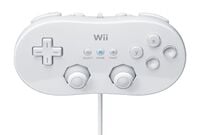
The Classic Controller is an extension or accessory for the Wii Remote. Besides the two analog sticks, the button layout resembles that of the Super Nintendo Entertainment System's controller. The Classic Controller must be used to play some Virtual Console games such as Super Mario 64 and Super Mario World. Some Wii games, such as Super Smash Bros. Brawl and Mario Kart Wii are compatible as well.
Just as the Nintendo GameCube was codenamed Dolphin and the Wii was codenamed Revolution, the Classic Controller was codenamed Shell.[13]
Classic Controller Pro
The Classic Controller Pro is an enhanced version of the Classic Controller, listed on Nintendo's Japanese website on February 26, 2009. This revision features the ![]() and
and ![]() buttons as full-fledged shoulder buttons, like the
buttons as full-fledged shoulder buttons, like the ![]() and
and ![]() buttons on the Nintendo GameCube controller, as well as added controller grips. However, the
buttons on the Nintendo GameCube controller, as well as added controller grips. However, the ![]() and
and ![]() buttons are no longer pressure-sensitive, unlike with the original Classic Controller. The controller is also slightly bigger than its old revision. The Classic Controller Pro was released in Japan on August 1, 2009 in both black and white colors. It was subsequently released in Europe and North America in November 2009[14] and April 2010[15] respectively (though only in black in Europe).
buttons are no longer pressure-sensitive, unlike with the original Classic Controller. The controller is also slightly bigger than its old revision. The Classic Controller Pro was released in Japan on August 1, 2009 in both black and white colors. It was subsequently released in Europe and North America in November 2009[14] and April 2010[15] respectively (though only in black in Europe).
Buttons and Sticks
- a (
 )
) - b (
 )
) - y (
 )
) - x (
 )
) - +Control Pad (
 )
) - Left Control Stick (
)
- Right Control Stick (
)
- L (
 )
) - R (
 )
) - ZL (
 )
) - ZR (
 )
) - + (
 )
) - - (
 )
) - Home (
 )
)
Wii Balance Board
The Wii Balance Board is a controller for the Wii that is used for various games, most prominently in Wii Fit. The Balance Board, unlike the Nunchuk or Classic Controller, acts as a separate controller and does not need to be connected to the Wii Remote. The Board is capable of measuring the weight, balance, and movement of the player that is using it. The only Super Mario game that ever used the Wii Balance Board was Mario & Sonic at the Olympic Winter Games.
Wii Wheel

The Wii Wheel is an accessory for the Wii that resembles a car steering wheel and is designed for Mario Kart Wii. One Wii Wheel is packaged with Mario Kart Wii, but more can be bought separately. The Wii Wheel is used to assist in holding the remote and may help players control the game more easily. The Wii Wheel does not connect to the Wii or Remote in any way and is used to only hold the Remote. Because of this, if only the Wii Remote is held sideways (without the Wheel) on Mario Kart Wii, it still shows that a wheel is being used.
Prototypes
The first prototype was made when Nintendo was trying to discover the best position to put the Wii Remote. Since Nintendo could not decide where the ![]() button would be used, there was nothing on the back. For the second prototype, Nintendo examined real go-kart wheels, and the company discovered that they are usually more square than round. The third prototype was the basis for the final Wii Wheel. This prototype had a window for using the Wii Menu and a hole for the
button would be used, there was nothing on the back. For the second prototype, Nintendo examined real go-kart wheels, and the company discovered that they are usually more square than round. The third prototype was the basis for the final Wii Wheel. This prototype had a window for using the Wii Menu and a hole for the ![]() button. The fourth prototype had a
button. The fourth prototype had a ![]() button in the Wii Wheel itself, so a child’s finger could reach. Finally, the fifth prototype had a two-tone color scheme. A pure white color scheme was eventually decided on to match the Wii Zapper and the Wii Balance Board. Kenichiro Ashida made two Wii Wheels to show at the "Iwata Asks" interview on Mario Kart Wii.
button in the Wii Wheel itself, so a child’s finger could reach. Finally, the fifth prototype had a two-tone color scheme. A pure white color scheme was eventually decided on to match the Wii Zapper and the Wii Balance Board. Kenichiro Ashida made two Wii Wheels to show at the "Iwata Asks" interview on Mario Kart Wii.
Gallery
The Gold Wheel was available only as a redeemable prize from Club Nintendo in Australia, Europe, Japan, and North America.
Nintendo GameCube Controller
The Nintendo GameCube Controller can also be used for certain games such as Mario Kart Wii and Virtual Console games, and as an alternative to the Wii Classic Controller (and the Pro version).
Super Mario appearances
WarioWare series
WarioWare: Smooth Moves
The Wii Remote (known as the Form Baton in the game) appears in several microgames in WarioWare: Smooth Moves, as well as an object in the game's story. The Nunchuk (known as the Balance Stone in the game) appears in Orbulon's microgames and story.
WarioWare: D.I.Y.
In the intro cutscene of WarioWare: D.I.Y., Dr. Crygor is playing a Wii game, as the console is seen near the TV.
WarioWare Gold
The Wii appears as a collectible Nintendo souvenir in WarioWare Gold.
WarioWare: Get It Together!
In 9-Volt's Nintendo Classics level in WarioWare: Get It Together!, the boss that appears in the intermission before the boss microgame wields a Wii Remote as a sword.
Super Paper Mario
When the player enters Francis's room in Fort Francis and flips, they can see a large TV and a Wii with a Wii Remote. Also, when the player fights Fracktail, Fracktail starts downloading information about Mario. While he is doing so, his eyes turn into the circle that appears when the Wii Shop Channel is loading from the Wii Menu.
Mario Kart Wii
In the cutscene before the file selection screen, Mario and Luigi use Wii Wheels to race and drive in invisible karts. Peach joins them with her own Wii Wheel, and their karts become visible shortly afterwards, with their Wii Wheels becoming their karts wheels.
Mario Super Sluggers

In the opening cinematic of Mario Super Sluggers, Daisy, Luigi, and Mario carry Wii Remotes with them as they run towards Mario Stadium. When Daisy brandishes the remote on the mound, it transforms into a baseball bat, and Luigi encounters the same method moments later. When Mario brandishes the remote, it transforms into a baseball.
Yoshi's Woolly World
Although the console itself does not appear in Yoshi's Woolly World, a Yoshi design based off the Wii can be unlocked in World 2-S: Perils of the Perplexing Pyramid.
Super Smash Bros. series
Starting with Super Smash Bros. for Nintendo 3DS, Wii Fit Trainer's entrance animation has them balancing on a Wii Balance Board before stepping off of it. In addition, the Wii Balance Board appears as a trophy in Super Smash Bros. for Wii U. The Wii Balance Board also appears as a master spirit in Super Smash Bros. Ultimate, teaching the Lightweight Style to other spirits (said style increases move speed and jump height, but decreases offense, defense, and weight). The Wii Balance Board spirit battle is against Wii Fit Trainer on the Wii Fit Studio stage with the music "Wii Fit Plus Medley" (from Wii Fit Plus) playing, with all fighters having increased movement speed and being easier to launch after some time.
Mario & Luigi: Superstar Saga + Bowser's Minions
In Mario & Luigi: Superstar Saga + Bowser's Minions, a Wii Wheel is found hanging on the wall in the Mario Bros.' House.
Galleries
System gallery
Black Wii bundle also consisting of New Super Mario Bros. Wii and the Super Mario Galaxy Original Soundtrack album
Wii's special red edition commemorating the 25th anniversary of the Super Mario franchise which comes with New Super Mario Bros. Wii
The Wii icon used to promote Super Mario 3D All-Stars
Accessory and controller gallery
Wario holding a Wii Remote for Wario Land: Shake It!
A Toad Wii Remote
A Bowser Wii Remote
A Peach-themed Wii Wheel
A Metal Mario-themed Wii Wheel
Game gallery
Media
- For a complete list of media for this subject, see List of Wii media.
| File info |
| File info |
| File info |
| File info |
Names in other languages
| Language | Name | Meaning | Notes |
|---|---|---|---|
| Japanese | ウィー[?] Wī |
Wii |
Trivia
- Because Virtual Console service and GameCube backwards compatibility, seven Mario Party titles are playable on the Wii, more than any other console to date.
References
- ^ http://www.gamespot.com/articles/nintendo-killing-online-support-for-mario-kart-wii-super-smash-bros-brawl-in-may/1100-6417983/
- ^ Brian (October 11, 2011). Black Wii Holiday Bundle with New Super Mario Bros. Wii and Exclusive Music CD Arriving Oct. 23. Nintendo Everything. Retrieved March 4, 2020.
- ^ Wii mini and Nintendo Selects - Launch Trailer (Wii) - Nintendo UK YouTube]
- ^ http://www.nintendo.com/whatsnew/detail/ONIEEqvK1pbPyTbW2lWO6QnPUiqqvuuI
- ^ Nintendo (February 26, 2013). New Wii mini console launching on 22nd March. Nintendo UK. Retrieved March 4, 2020.
- ^ http://www.nintendo.com/whatsnew/detail/a1kK4i_X_mWqfKuJPllLEHmoP_hJnJOq
- ^ http://www.nintendo.com/whatsnew/detail/tiQImp7Oi97LiEyVqwDqL-eDnX6u9qjk
- ^ Sell, Benjamin. How to Transfer Miis to 3DS (or Transfer Miis from the Wii to the 3DS). GameYum. Retrieved March 3, 2020.
- ^ Romano, Sal (September 29, 2017). Wii Shop Channel to end service on January 31, 2019. Gematsu. Retrieved March 4, 2020.
- ^ Official traditional Chinese website for Mario Kart Wii. Retrieved September 4, 2021.
- ^ From the unused Simplified Chinese Wii System Menu text
- ^ https://www.nintendo.com.hk/wii/wii_console.htm
- ^ Gibson, Ellie (September 19, 2005). Jim Merrick Takes Control. Eurogamer. Retrieved March 4, 2020.
- ^ Siliconera Staff (October 20, 2009). Black Wii Bundle, Classic Controller Pro Dated For Europe. Siliconera. Retrieved April 28, 2022.
- ^ Davies, C. (January 25, 2010). Wii Classic Controller Pro Hits US From April 2010. SlashGear. Retrieved April 28, 2022.


